Entrepreneurship and Small Business Management: Venture Analysis UK
VerifiedAdded on 2024/07/01
|23
|4718
|468
Report
AI Summary
This report provides an in-depth analysis of entrepreneurship and small business management, focusing on various types of entrepreneurial ventures and their relationship to the typology of entrepreneurship. It explores the similarities and differences between ventures, examining their impact on the economy, particularly in the UK. The report assesses the role of micro and small businesses in the social economy, evaluating their differences from medium and large businesses using relevant data and statistics. Furthermore, it determines the characteristic traits and skills of successful entrepreneurs, differentiating them from other business managers, and assesses how entrepreneurial personality reflects motivation and mindset. The report also examines how background and experience can hinder or foster growth, analyzing the link between entrepreneurial characteristics and personal background, with specific examples of successful entrepreneurs. Desklib provides access to similar reports and solved assignments for students.

ENTREPRENEURSHIP
AND SMALL BUSINESS
MANAGEMENT
AND SMALL BUSINESS
MANAGEMENT
Paraphrase This Document
Need a fresh take? Get an instant paraphrase of this document with our AI Paraphraser
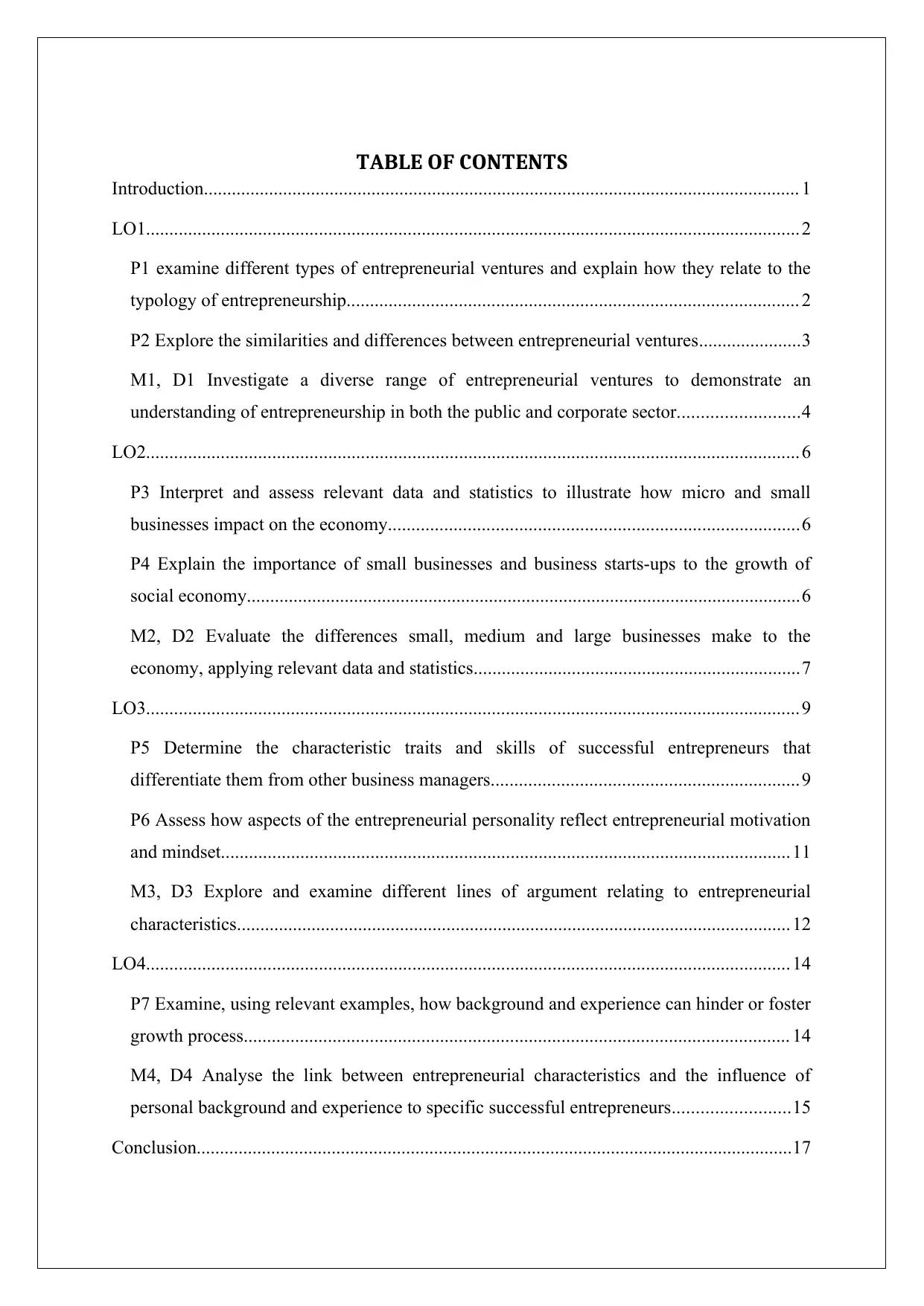
TABLE OF CONTENTS
Introduction................................................................................................................................ 1
LO1............................................................................................................................................ 2
P1 examine different types of entrepreneurial ventures and explain how they relate to the
typology of entrepreneurship................................................................................................. 2
P2 Explore the similarities and differences between entrepreneurial ventures......................3
M1, D1 Investigate a diverse range of entrepreneurial ventures to demonstrate an
understanding of entrepreneurship in both the public and corporate sector..........................4
LO2............................................................................................................................................ 6
P3 Interpret and assess relevant data and statistics to illustrate how micro and small
businesses impact on the economy........................................................................................6
P4 Explain the importance of small businesses and business starts-ups to the growth of
social economy.......................................................................................................................6
M2, D2 Evaluate the differences small, medium and large businesses make to the
economy, applying relevant data and statistics......................................................................7
LO3............................................................................................................................................ 9
P5 Determine the characteristic traits and skills of successful entrepreneurs that
differentiate them from other business managers..................................................................9
P6 Assess how aspects of the entrepreneurial personality reflect entrepreneurial motivation
and mindset..........................................................................................................................11
M3, D3 Explore and examine different lines of argument relating to entrepreneurial
characteristics....................................................................................................................... 12
LO4.......................................................................................................................................... 14
P7 Examine, using relevant examples, how background and experience can hinder or foster
growth process..................................................................................................................... 14
M4, D4 Analyse the link between entrepreneurial characteristics and the influence of
personal background and experience to specific successful entrepreneurs.........................15
Conclusion................................................................................................................................17
Introduction................................................................................................................................ 1
LO1............................................................................................................................................ 2
P1 examine different types of entrepreneurial ventures and explain how they relate to the
typology of entrepreneurship................................................................................................. 2
P2 Explore the similarities and differences between entrepreneurial ventures......................3
M1, D1 Investigate a diverse range of entrepreneurial ventures to demonstrate an
understanding of entrepreneurship in both the public and corporate sector..........................4
LO2............................................................................................................................................ 6
P3 Interpret and assess relevant data and statistics to illustrate how micro and small
businesses impact on the economy........................................................................................6
P4 Explain the importance of small businesses and business starts-ups to the growth of
social economy.......................................................................................................................6
M2, D2 Evaluate the differences small, medium and large businesses make to the
economy, applying relevant data and statistics......................................................................7
LO3............................................................................................................................................ 9
P5 Determine the characteristic traits and skills of successful entrepreneurs that
differentiate them from other business managers..................................................................9
P6 Assess how aspects of the entrepreneurial personality reflect entrepreneurial motivation
and mindset..........................................................................................................................11
M3, D3 Explore and examine different lines of argument relating to entrepreneurial
characteristics....................................................................................................................... 12
LO4.......................................................................................................................................... 14
P7 Examine, using relevant examples, how background and experience can hinder or foster
growth process..................................................................................................................... 14
M4, D4 Analyse the link between entrepreneurial characteristics and the influence of
personal background and experience to specific successful entrepreneurs.........................15
Conclusion................................................................................................................................17

References................................................................................................................................ 18
LIST OF FIGURES
Figure 1: Types of entrepreneur................................................................................................. 3
Figure 2: Steve Jobs...................................................................................................................9
Figure 3: J.K. Rowling............................................................................................................. 10
Figure 4: Self motivation theory..............................................................................................12
Figure 5: Bill Gates.................................................................................................................. 15
LIST OF FIGURES
Figure 1: Types of entrepreneur................................................................................................. 3
Figure 2: Steve Jobs...................................................................................................................9
Figure 3: J.K. Rowling............................................................................................................. 10
Figure 4: Self motivation theory..............................................................................................12
Figure 5: Bill Gates.................................................................................................................. 15
⊘ This is a preview!⊘
Do you want full access?
Subscribe today to unlock all pages.

Trusted by 1+ million students worldwide

LIST OF TABLES
Table 1: Comparison of similarities and differences.................................................................3
Table 2: differences and similarities.......................................................................................... 4
1
Table 1: Comparison of similarities and differences.................................................................3
Table 2: differences and similarities.......................................................................................... 4
1
Paraphrase This Document
Need a fresh take? Get an instant paraphrase of this document with our AI Paraphraser
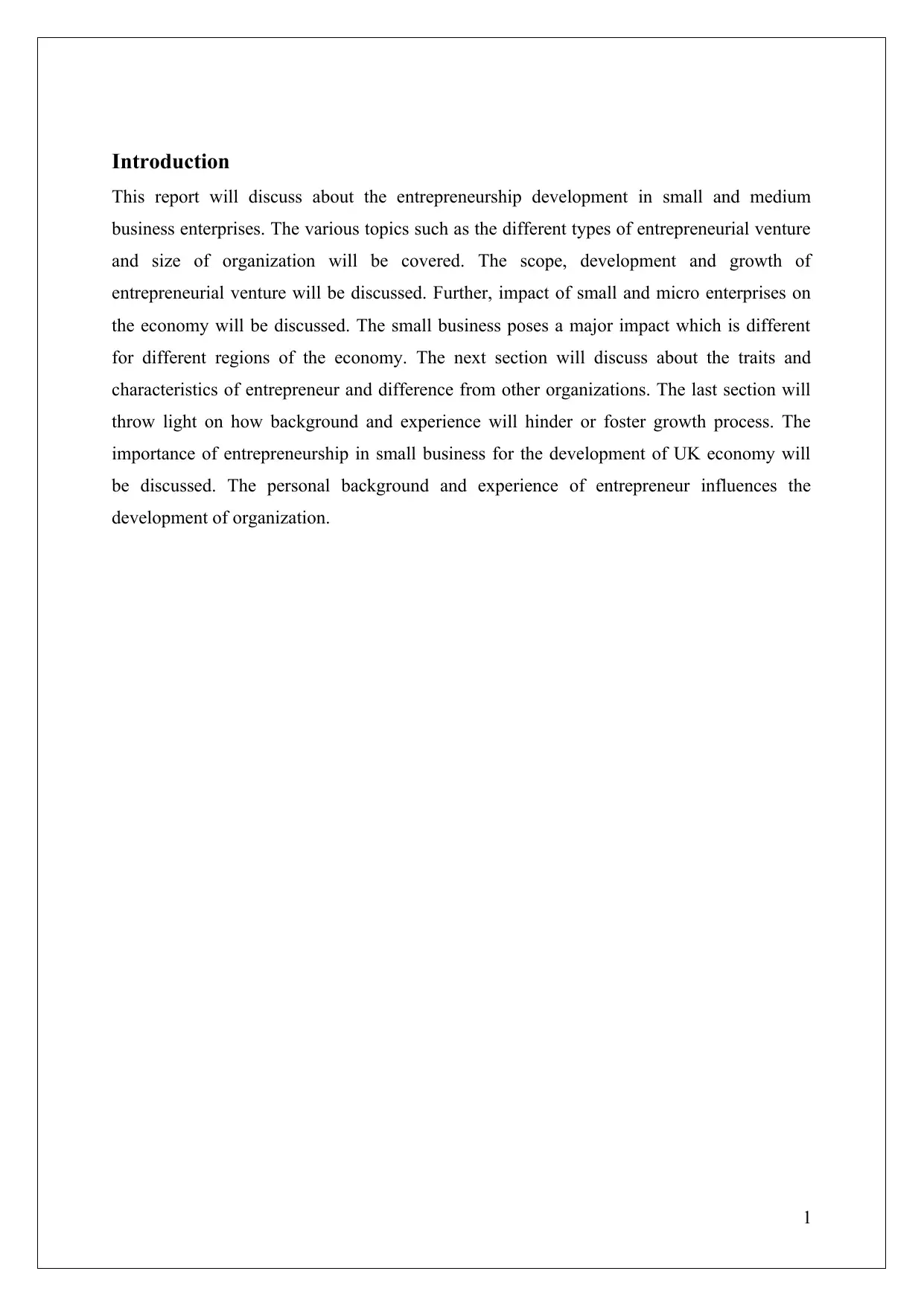
Introduction
This report will discuss about the entrepreneurship development in small and medium
business enterprises. The various topics such as the different types of entrepreneurial venture
and size of organization will be covered. The scope, development and growth of
entrepreneurial venture will be discussed. Further, impact of small and micro enterprises on
the economy will be discussed. The small business poses a major impact which is different
for different regions of the economy. The next section will discuss about the traits and
characteristics of entrepreneur and difference from other organizations. The last section will
throw light on how background and experience will hinder or foster growth process. The
importance of entrepreneurship in small business for the development of UK economy will
be discussed. The personal background and experience of entrepreneur influences the
development of organization.
1
This report will discuss about the entrepreneurship development in small and medium
business enterprises. The various topics such as the different types of entrepreneurial venture
and size of organization will be covered. The scope, development and growth of
entrepreneurial venture will be discussed. Further, impact of small and micro enterprises on
the economy will be discussed. The small business poses a major impact which is different
for different regions of the economy. The next section will discuss about the traits and
characteristics of entrepreneur and difference from other organizations. The last section will
throw light on how background and experience will hinder or foster growth process. The
importance of entrepreneurship in small business for the development of UK economy will
be discussed. The personal background and experience of entrepreneur influences the
development of organization.
1
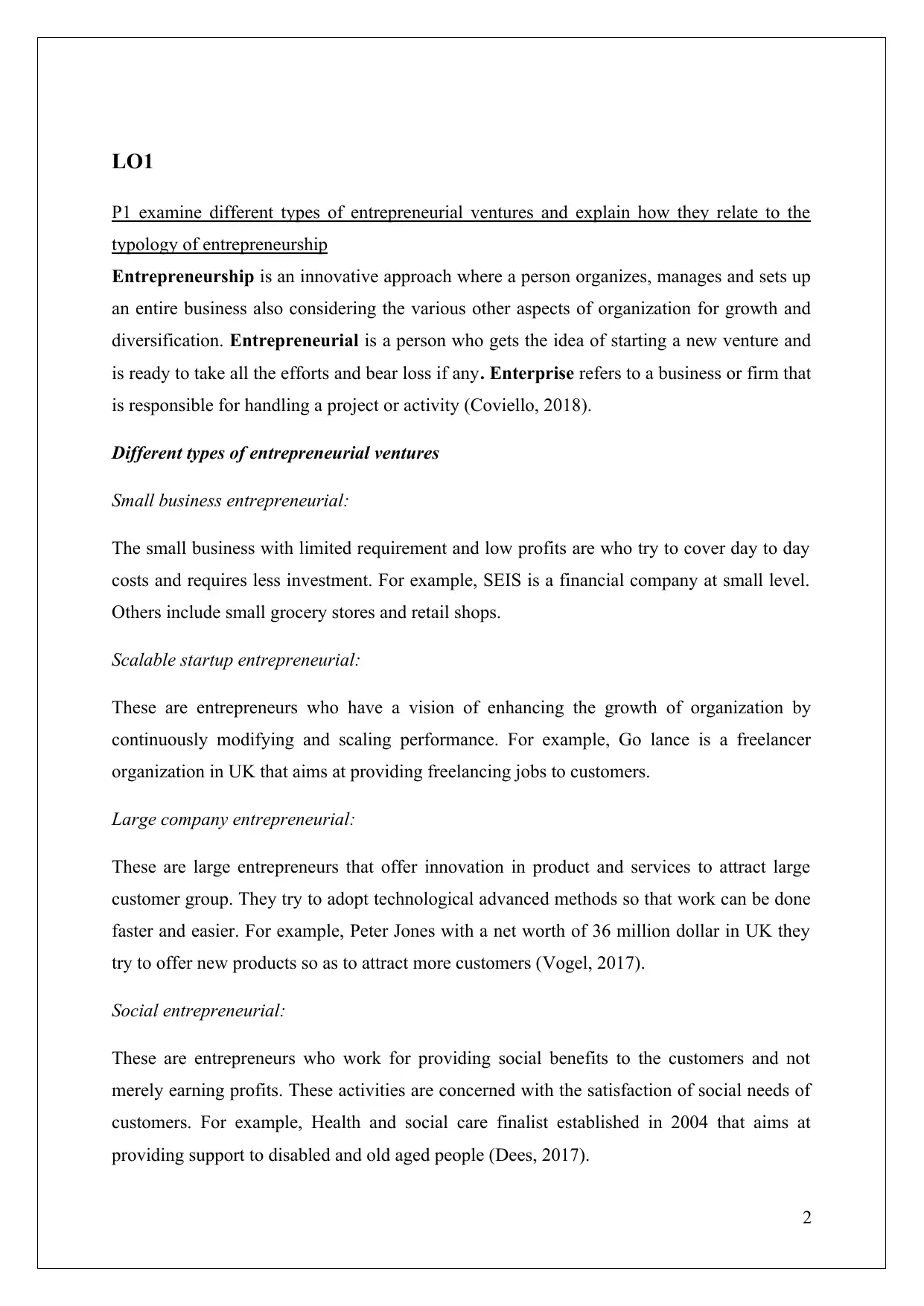
LO1
P1 examine different types of entrepreneurial ventures and explain how they relate to the
typology of entrepreneurship
Entrepreneurship is an innovative approach where a person organizes, manages and sets up
an entire business also considering the various other aspects of organization for growth and
diversification. Entrepreneurial is a person who gets the idea of starting a new venture and
is ready to take all the efforts and bear loss if any. Enterprise refers to a business or firm that
is responsible for handling a project or activity (Coviello, 2018).
Different types of entrepreneurial ventures
Small business entrepreneurial:
The small business with limited requirement and low profits are who try to cover day to day
costs and requires less investment. For example, SEIS is a financial company at small level.
Others include small grocery stores and retail shops.
Scalable startup entrepreneurial:
These are entrepreneurs who have a vision of enhancing the growth of organization by
continuously modifying and scaling performance. For example, Go lance is a freelancer
organization in UK that aims at providing freelancing jobs to customers.
Large company entrepreneurial:
These are large entrepreneurs that offer innovation in product and services to attract large
customer group. They try to adopt technological advanced methods so that work can be done
faster and easier. For example, Peter Jones with a net worth of 36 million dollar in UK they
try to offer new products so as to attract more customers (Vogel, 2017).
Social entrepreneurial:
These are entrepreneurs who work for providing social benefits to the customers and not
merely earning profits. These activities are concerned with the satisfaction of social needs of
customers. For example, Health and social care finalist established in 2004 that aims at
providing support to disabled and old aged people (Dees, 2017).
2
P1 examine different types of entrepreneurial ventures and explain how they relate to the
typology of entrepreneurship
Entrepreneurship is an innovative approach where a person organizes, manages and sets up
an entire business also considering the various other aspects of organization for growth and
diversification. Entrepreneurial is a person who gets the idea of starting a new venture and
is ready to take all the efforts and bear loss if any. Enterprise refers to a business or firm that
is responsible for handling a project or activity (Coviello, 2018).
Different types of entrepreneurial ventures
Small business entrepreneurial:
The small business with limited requirement and low profits are who try to cover day to day
costs and requires less investment. For example, SEIS is a financial company at small level.
Others include small grocery stores and retail shops.
Scalable startup entrepreneurial:
These are entrepreneurs who have a vision of enhancing the growth of organization by
continuously modifying and scaling performance. For example, Go lance is a freelancer
organization in UK that aims at providing freelancing jobs to customers.
Large company entrepreneurial:
These are large entrepreneurs that offer innovation in product and services to attract large
customer group. They try to adopt technological advanced methods so that work can be done
faster and easier. For example, Peter Jones with a net worth of 36 million dollar in UK they
try to offer new products so as to attract more customers (Vogel, 2017).
Social entrepreneurial:
These are entrepreneurs who work for providing social benefits to the customers and not
merely earning profits. These activities are concerned with the satisfaction of social needs of
customers. For example, Health and social care finalist established in 2004 that aims at
providing support to disabled and old aged people (Dees, 2017).
2
⊘ This is a preview!⊘
Do you want full access?
Subscribe today to unlock all pages.

Trusted by 1+ million students worldwide
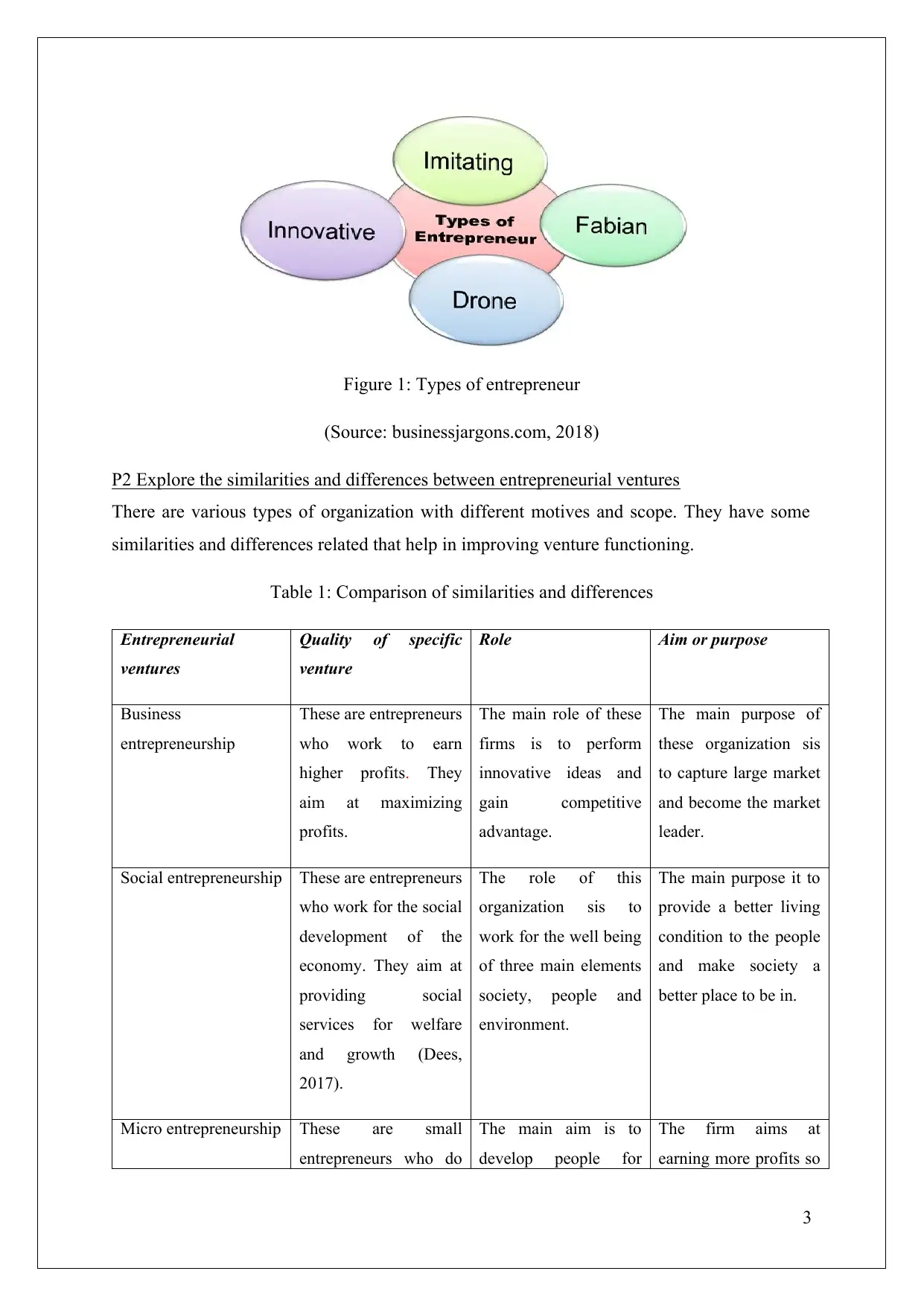
Figure 1: Types of entrepreneur
(Source: businessjargons.com, 2018)
P2 Explore the similarities and differences between entrepreneurial ventures
There are various types of organization with different motives and scope. They have some
similarities and differences related that help in improving venture functioning.
Table 1: Comparison of similarities and differences
Entrepreneurial
ventures
Quality of specific
venture
Role Aim or purpose
Business
entrepreneurship
These are entrepreneurs
who work to earn
higher profits. They
aim at maximizing
profits.
The main role of these
firms is to perform
innovative ideas and
gain competitive
advantage.
The main purpose of
these organization sis
to capture large market
and become the market
leader.
Social entrepreneurship These are entrepreneurs
who work for the social
development of the
economy. They aim at
providing social
services for welfare
and growth (Dees,
2017).
The role of this
organization sis to
work for the well being
of three main elements
society, people and
environment.
The main purpose it to
provide a better living
condition to the people
and make society a
better place to be in.
Micro entrepreneurship These are small
entrepreneurs who do
The main aim is to
develop people for
The firm aims at
earning more profits so
3
(Source: businessjargons.com, 2018)
P2 Explore the similarities and differences between entrepreneurial ventures
There are various types of organization with different motives and scope. They have some
similarities and differences related that help in improving venture functioning.
Table 1: Comparison of similarities and differences
Entrepreneurial
ventures
Quality of specific
venture
Role Aim or purpose
Business
entrepreneurship
These are entrepreneurs
who work to earn
higher profits. They
aim at maximizing
profits.
The main role of these
firms is to perform
innovative ideas and
gain competitive
advantage.
The main purpose of
these organization sis
to capture large market
and become the market
leader.
Social entrepreneurship These are entrepreneurs
who work for the social
development of the
economy. They aim at
providing social
services for welfare
and growth (Dees,
2017).
The role of this
organization sis to
work for the well being
of three main elements
society, people and
environment.
The main purpose it to
provide a better living
condition to the people
and make society a
better place to be in.
Micro entrepreneurship These are small
entrepreneurs who do
The main aim is to
develop people for
The firm aims at
earning more profits so
3
Paraphrase This Document
Need a fresh take? Get an instant paraphrase of this document with our AI Paraphraser
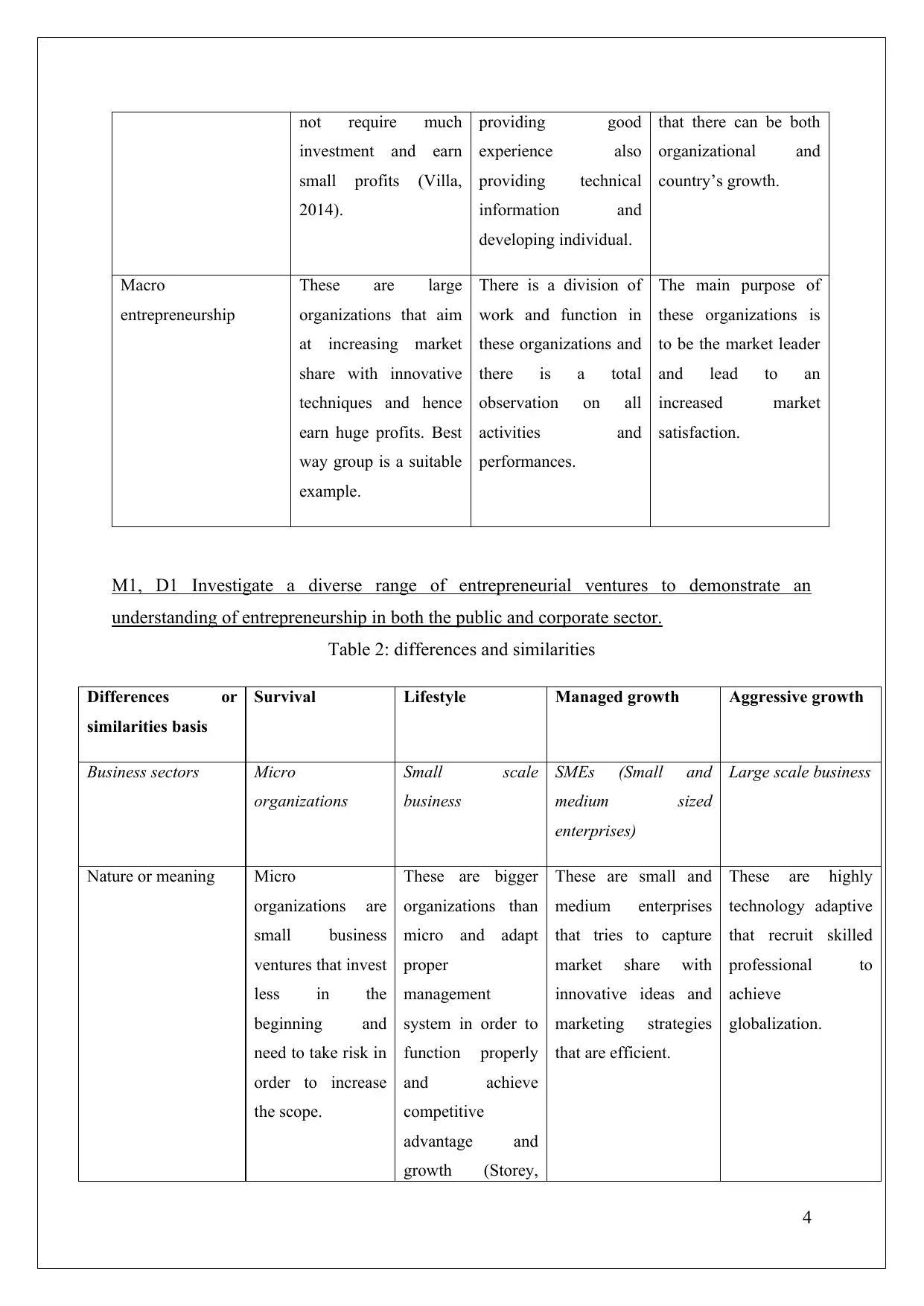
not require much
investment and earn
small profits (Villa,
2014).
providing good
experience also
providing technical
information and
developing individual.
that there can be both
organizational and
country’s growth.
Macro
entrepreneurship
These are large
organizations that aim
at increasing market
share with innovative
techniques and hence
earn huge profits. Best
way group is a suitable
example.
There is a division of
work and function in
these organizations and
there is a total
observation on all
activities and
performances.
The main purpose of
these organizations is
to be the market leader
and lead to an
increased market
satisfaction.
M1, D1 Investigate a diverse range of entrepreneurial ventures to demonstrate an
understanding of entrepreneurship in both the public and corporate sector.
Table 2: differences and similarities
Differences or
similarities basis
Survival Lifestyle Managed growth Aggressive growth
Business sectors Micro
organizations
Small scale
business
SMEs (Small and
medium sized
enterprises)
Large scale business
Nature or meaning Micro
organizations are
small business
ventures that invest
less in the
beginning and
need to take risk in
order to increase
the scope.
These are bigger
organizations than
micro and adapt
proper
management
system in order to
function properly
and achieve
competitive
advantage and
growth (Storey,
These are small and
medium enterprises
that tries to capture
market share with
innovative ideas and
marketing strategies
that are efficient.
These are highly
technology adaptive
that recruit skilled
professional to
achieve
globalization.
4
investment and earn
small profits (Villa,
2014).
providing good
experience also
providing technical
information and
developing individual.
that there can be both
organizational and
country’s growth.
Macro
entrepreneurship
These are large
organizations that aim
at increasing market
share with innovative
techniques and hence
earn huge profits. Best
way group is a suitable
example.
There is a division of
work and function in
these organizations and
there is a total
observation on all
activities and
performances.
The main purpose of
these organizations is
to be the market leader
and lead to an
increased market
satisfaction.
M1, D1 Investigate a diverse range of entrepreneurial ventures to demonstrate an
understanding of entrepreneurship in both the public and corporate sector.
Table 2: differences and similarities
Differences or
similarities basis
Survival Lifestyle Managed growth Aggressive growth
Business sectors Micro
organizations
Small scale
business
SMEs (Small and
medium sized
enterprises)
Large scale business
Nature or meaning Micro
organizations are
small business
ventures that invest
less in the
beginning and
need to take risk in
order to increase
the scope.
These are bigger
organizations than
micro and adapt
proper
management
system in order to
function properly
and achieve
competitive
advantage and
growth (Storey,
These are small and
medium enterprises
that tries to capture
market share with
innovative ideas and
marketing strategies
that are efficient.
These are highly
technology adaptive
that recruit skilled
professional to
achieve
globalization.
4
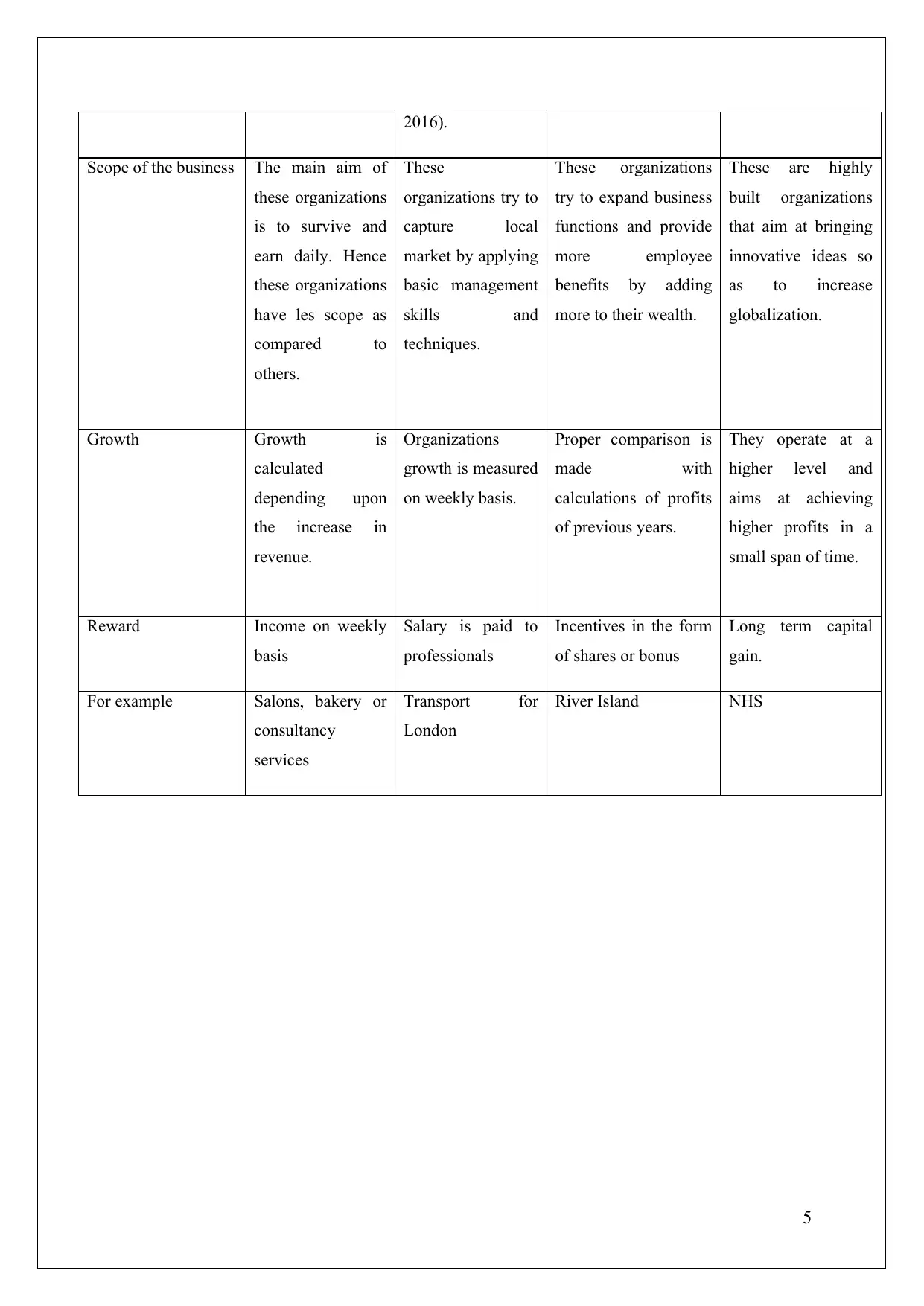
2016).
Scope of the business The main aim of
these organizations
is to survive and
earn daily. Hence
these organizations
have les scope as
compared to
others.
These
organizations try to
capture local
market by applying
basic management
skills and
techniques.
These organizations
try to expand business
functions and provide
more employee
benefits by adding
more to their wealth.
These are highly
built organizations
that aim at bringing
innovative ideas so
as to increase
globalization.
Growth Growth is
calculated
depending upon
the increase in
revenue.
Organizations
growth is measured
on weekly basis.
Proper comparison is
made with
calculations of profits
of previous years.
They operate at a
higher level and
aims at achieving
higher profits in a
small span of time.
Reward Income on weekly
basis
Salary is paid to
professionals
Incentives in the form
of shares or bonus
Long term capital
gain.
For example Salons, bakery or
consultancy
services
Transport for
London
River Island NHS
5
Scope of the business The main aim of
these organizations
is to survive and
earn daily. Hence
these organizations
have les scope as
compared to
others.
These
organizations try to
capture local
market by applying
basic management
skills and
techniques.
These organizations
try to expand business
functions and provide
more employee
benefits by adding
more to their wealth.
These are highly
built organizations
that aim at bringing
innovative ideas so
as to increase
globalization.
Growth Growth is
calculated
depending upon
the increase in
revenue.
Organizations
growth is measured
on weekly basis.
Proper comparison is
made with
calculations of profits
of previous years.
They operate at a
higher level and
aims at achieving
higher profits in a
small span of time.
Reward Income on weekly
basis
Salary is paid to
professionals
Incentives in the form
of shares or bonus
Long term capital
gain.
For example Salons, bakery or
consultancy
services
Transport for
London
River Island NHS
5
⊘ This is a preview!⊘
Do you want full access?
Subscribe today to unlock all pages.

Trusted by 1+ million students worldwide
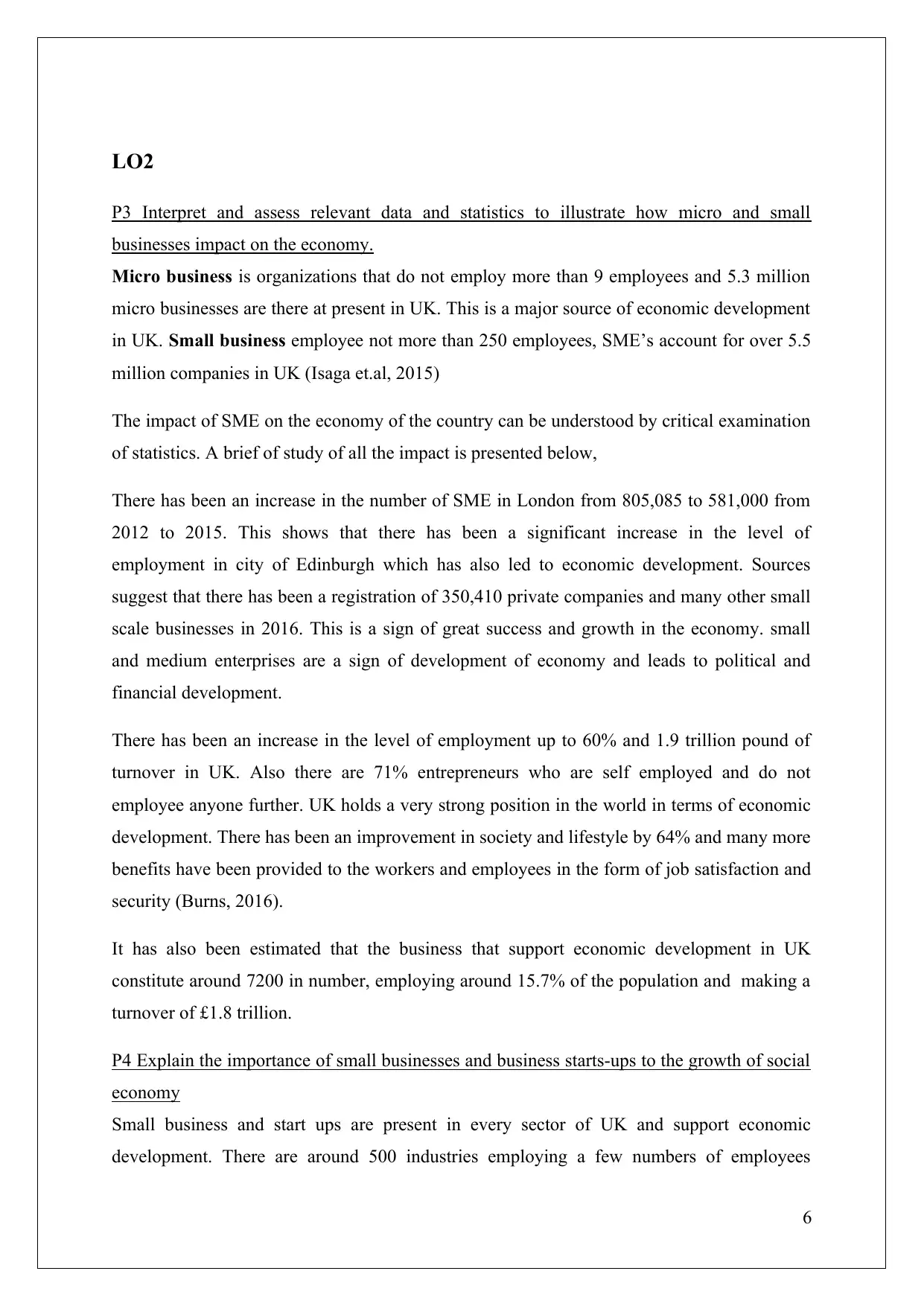
LO2
P3 Interpret and assess relevant data and statistics to illustrate how micro and small
businesses impact on the economy.
Micro business is organizations that do not employ more than 9 employees and 5.3 million
micro businesses are there at present in UK. This is a major source of economic development
in UK. Small business employee not more than 250 employees, SME’s account for over 5.5
million companies in UK (Isaga et.al, 2015)
The impact of SME on the economy of the country can be understood by critical examination
of statistics. A brief of study of all the impact is presented below,
There has been an increase in the number of SME in London from 805,085 to 581,000 from
2012 to 2015. This shows that there has been a significant increase in the level of
employment in city of Edinburgh which has also led to economic development. Sources
suggest that there has been a registration of 350,410 private companies and many other small
scale businesses in 2016. This is a sign of great success and growth in the economy. small
and medium enterprises are a sign of development of economy and leads to political and
financial development.
There has been an increase in the level of employment up to 60% and 1.9 trillion pound of
turnover in UK. Also there are 71% entrepreneurs who are self employed and do not
employee anyone further. UK holds a very strong position in the world in terms of economic
development. There has been an improvement in society and lifestyle by 64% and many more
benefits have been provided to the workers and employees in the form of job satisfaction and
security (Burns, 2016).
It has also been estimated that the business that support economic development in UK
constitute around 7200 in number, employing around 15.7% of the population and making a
turnover of £1.8 trillion.
P4 Explain the importance of small businesses and business starts-ups to the growth of social
economy
Small business and start ups are present in every sector of UK and support economic
development. There are around 500 industries employing a few numbers of employees
6
P3 Interpret and assess relevant data and statistics to illustrate how micro and small
businesses impact on the economy.
Micro business is organizations that do not employ more than 9 employees and 5.3 million
micro businesses are there at present in UK. This is a major source of economic development
in UK. Small business employee not more than 250 employees, SME’s account for over 5.5
million companies in UK (Isaga et.al, 2015)
The impact of SME on the economy of the country can be understood by critical examination
of statistics. A brief of study of all the impact is presented below,
There has been an increase in the number of SME in London from 805,085 to 581,000 from
2012 to 2015. This shows that there has been a significant increase in the level of
employment in city of Edinburgh which has also led to economic development. Sources
suggest that there has been a registration of 350,410 private companies and many other small
scale businesses in 2016. This is a sign of great success and growth in the economy. small
and medium enterprises are a sign of development of economy and leads to political and
financial development.
There has been an increase in the level of employment up to 60% and 1.9 trillion pound of
turnover in UK. Also there are 71% entrepreneurs who are self employed and do not
employee anyone further. UK holds a very strong position in the world in terms of economic
development. There has been an improvement in society and lifestyle by 64% and many more
benefits have been provided to the workers and employees in the form of job satisfaction and
security (Burns, 2016).
It has also been estimated that the business that support economic development in UK
constitute around 7200 in number, employing around 15.7% of the population and making a
turnover of £1.8 trillion.
P4 Explain the importance of small businesses and business starts-ups to the growth of social
economy
Small business and start ups are present in every sector of UK and support economic
development. There are around 500 industries employing a few numbers of employees
6
Paraphrase This Document
Need a fresh take? Get an instant paraphrase of this document with our AI Paraphraser
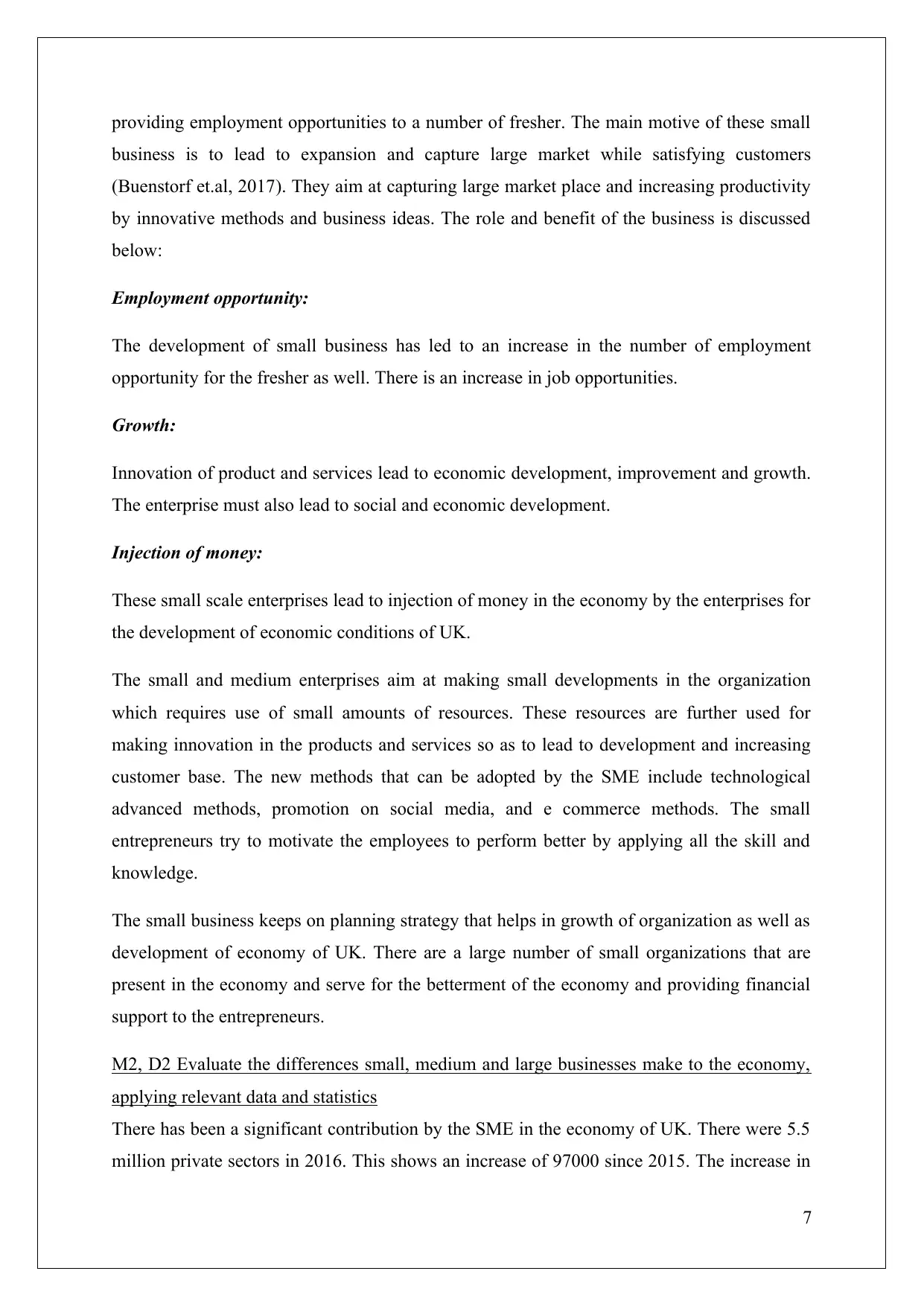
providing employment opportunities to a number of fresher. The main motive of these small
business is to lead to expansion and capture large market while satisfying customers
(Buenstorf et.al, 2017). They aim at capturing large market place and increasing productivity
by innovative methods and business ideas. The role and benefit of the business is discussed
below:
Employment opportunity:
The development of small business has led to an increase in the number of employment
opportunity for the fresher as well. There is an increase in job opportunities.
Growth:
Innovation of product and services lead to economic development, improvement and growth.
The enterprise must also lead to social and economic development.
Injection of money:
These small scale enterprises lead to injection of money in the economy by the enterprises for
the development of economic conditions of UK.
The small and medium enterprises aim at making small developments in the organization
which requires use of small amounts of resources. These resources are further used for
making innovation in the products and services so as to lead to development and increasing
customer base. The new methods that can be adopted by the SME include technological
advanced methods, promotion on social media, and e commerce methods. The small
entrepreneurs try to motivate the employees to perform better by applying all the skill and
knowledge.
The small business keeps on planning strategy that helps in growth of organization as well as
development of economy of UK. There are a large number of small organizations that are
present in the economy and serve for the betterment of the economy and providing financial
support to the entrepreneurs.
M2, D2 Evaluate the differences small, medium and large businesses make to the economy,
applying relevant data and statistics
There has been a significant contribution by the SME in the economy of UK. There were 5.5
million private sectors in 2016. This shows an increase of 97000 since 2015. The increase in
7
business is to lead to expansion and capture large market while satisfying customers
(Buenstorf et.al, 2017). They aim at capturing large market place and increasing productivity
by innovative methods and business ideas. The role and benefit of the business is discussed
below:
Employment opportunity:
The development of small business has led to an increase in the number of employment
opportunity for the fresher as well. There is an increase in job opportunities.
Growth:
Innovation of product and services lead to economic development, improvement and growth.
The enterprise must also lead to social and economic development.
Injection of money:
These small scale enterprises lead to injection of money in the economy by the enterprises for
the development of economic conditions of UK.
The small and medium enterprises aim at making small developments in the organization
which requires use of small amounts of resources. These resources are further used for
making innovation in the products and services so as to lead to development and increasing
customer base. The new methods that can be adopted by the SME include technological
advanced methods, promotion on social media, and e commerce methods. The small
entrepreneurs try to motivate the employees to perform better by applying all the skill and
knowledge.
The small business keeps on planning strategy that helps in growth of organization as well as
development of economy of UK. There are a large number of small organizations that are
present in the economy and serve for the betterment of the economy and providing financial
support to the entrepreneurs.
M2, D2 Evaluate the differences small, medium and large businesses make to the economy,
applying relevant data and statistics
There has been a significant contribution by the SME in the economy of UK. There were 5.5
million private sectors in 2016. This shows an increase of 97000 since 2015. The increase in
7
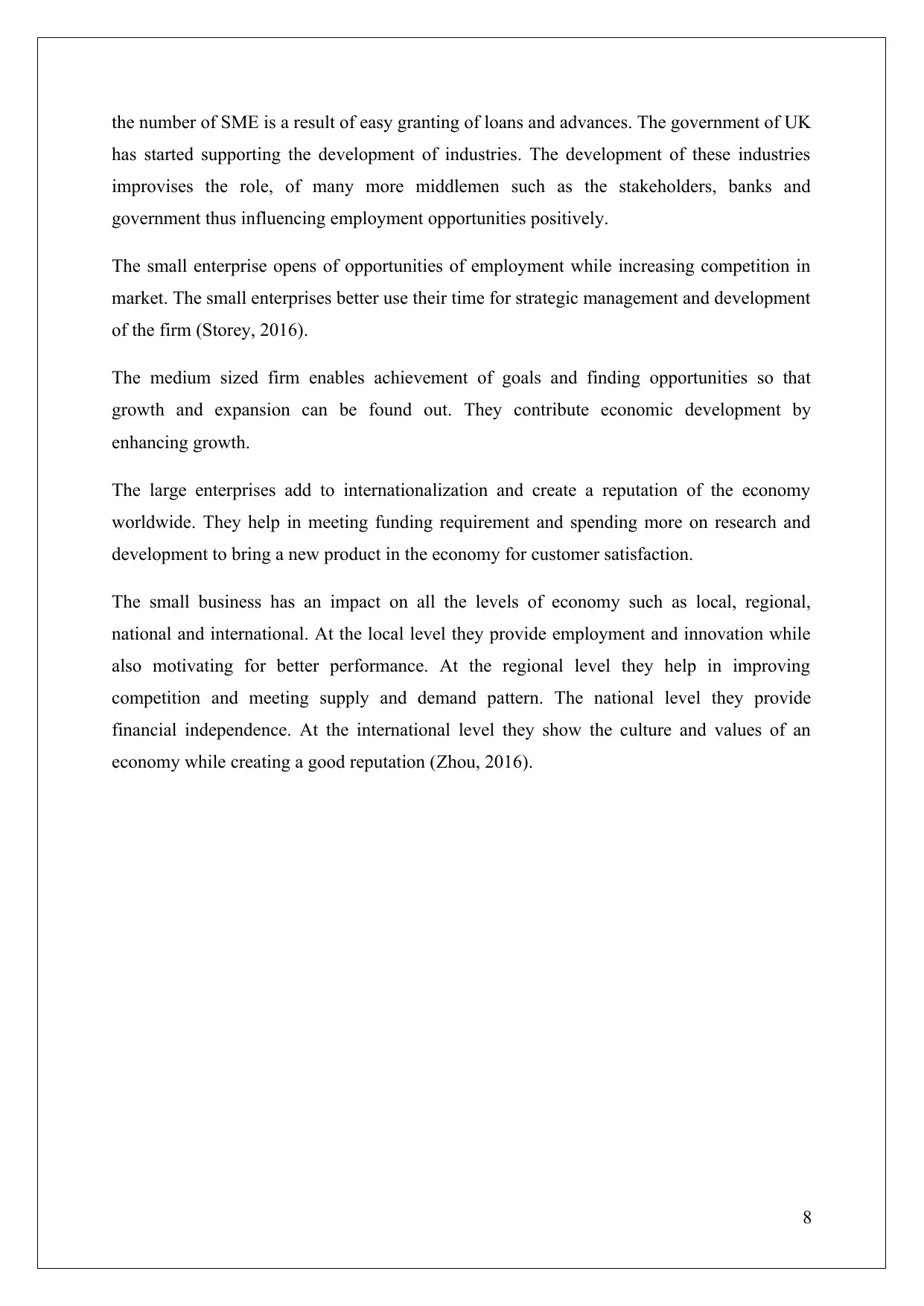
the number of SME is a result of easy granting of loans and advances. The government of UK
has started supporting the development of industries. The development of these industries
improvises the role, of many more middlemen such as the stakeholders, banks and
government thus influencing employment opportunities positively.
The small enterprise opens of opportunities of employment while increasing competition in
market. The small enterprises better use their time for strategic management and development
of the firm (Storey, 2016).
The medium sized firm enables achievement of goals and finding opportunities so that
growth and expansion can be found out. They contribute economic development by
enhancing growth.
The large enterprises add to internationalization and create a reputation of the economy
worldwide. They help in meeting funding requirement and spending more on research and
development to bring a new product in the economy for customer satisfaction.
The small business has an impact on all the levels of economy such as local, regional,
national and international. At the local level they provide employment and innovation while
also motivating for better performance. At the regional level they help in improving
competition and meeting supply and demand pattern. The national level they provide
financial independence. At the international level they show the culture and values of an
economy while creating a good reputation (Zhou, 2016).
8
has started supporting the development of industries. The development of these industries
improvises the role, of many more middlemen such as the stakeholders, banks and
government thus influencing employment opportunities positively.
The small enterprise opens of opportunities of employment while increasing competition in
market. The small enterprises better use their time for strategic management and development
of the firm (Storey, 2016).
The medium sized firm enables achievement of goals and finding opportunities so that
growth and expansion can be found out. They contribute economic development by
enhancing growth.
The large enterprises add to internationalization and create a reputation of the economy
worldwide. They help in meeting funding requirement and spending more on research and
development to bring a new product in the economy for customer satisfaction.
The small business has an impact on all the levels of economy such as local, regional,
national and international. At the local level they provide employment and innovation while
also motivating for better performance. At the regional level they help in improving
competition and meeting supply and demand pattern. The national level they provide
financial independence. At the international level they show the culture and values of an
economy while creating a good reputation (Zhou, 2016).
8
⊘ This is a preview!⊘
Do you want full access?
Subscribe today to unlock all pages.

Trusted by 1+ million students worldwide
1 out of 23
Related Documents
Your All-in-One AI-Powered Toolkit for Academic Success.
+13062052269
info@desklib.com
Available 24*7 on WhatsApp / Email
![[object Object]](/_next/static/media/star-bottom.7253800d.svg)
Unlock your academic potential
Copyright © 2020–2025 A2Z Services. All Rights Reserved. Developed and managed by ZUCOL.


